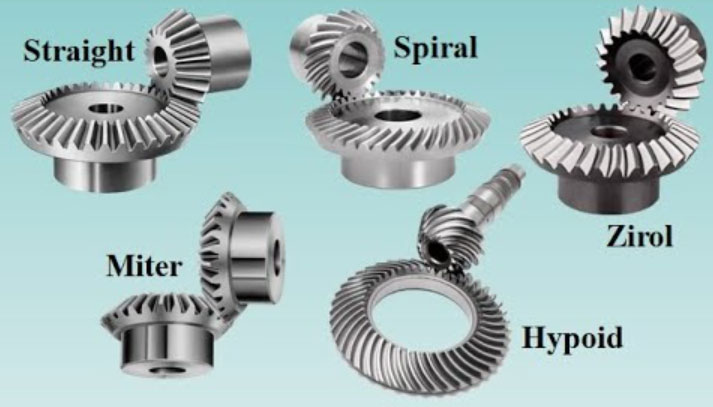Bevel gears and spur gears are two commonly used types of gears in mechanical systems. While both serve the purpose of transmitting power and motion, they have distinct design characteristics and offer different advantages. Let’s compare bevel gears and spur gears in various aspects:

- Tooth Profile:
- Bevel Gears: Bevel gears have conical-shaped teeth that are cut on the surface of a cone. The tooth profile allows for smooth and efficient power transmission between intersecting shafts at various angles. Bevel gears can have straight, spiral, or hypoid tooth profiles depending on the application.
- Spur Gears: Spur gears have cylindrical-shaped teeth that are cut parallel to the gear axis. The teeth are straight and extend radially from the gear’s center. Spur gears offer efficient power transmission between parallel shafts.
- Gear Orientation:
- Bevel Gears: Bevel gears are designed to transmit power between intersecting shafts at an angle. They can be configured for both right-angle (90 degrees) and non-right-angle (other angles) applications. This allows for versatile power transmission in systems where shafts need to change direction or intersect.
- Spur Gears: Spur gears are used for power transmission between parallel shafts. They are typically arranged in a side-by-side configuration.
- Efficiency:
- Bevel Gears: Bevel gears can achieve high efficiency when properly designed and manufactured. The conical tooth profile and accurate meshing provide efficient power transfer. However, efficiency can decrease in bevel gears with high ratios or non-ideal tooth contact patterns.
- Spur Gears: Spur gears offer high efficiency due to their straight tooth profile and simple meshing mechanism. The teeth of spur gears engage in a rolling contact, resulting in minimal sliding and power losses.
- Load Capacity:
- Bevel Gears: Bevel gears have good load-carrying capabilities, especially when designed with high-quality materials and proper tooth geometry. They can handle both radial and thrust loads, making them suitable for applications with significant loads and forces.
- Spur Gears: Spur gears are known for their high load capacity in parallel shaft applications. The teeth of spur gears distribute the load evenly along the gear face, allowing them to handle substantial radial loads.
- Noise and Vibration:
- Bevel Gears: Bevel gears, particularly those with spiral or hypoid tooth profiles, have the advantage of reduced noise and vibration compared to spur gears. The spiral/hypoid teeth enable gradual tooth engagement, resulting in smoother operation and reduced gear noise.
- Spur Gears: Spur gears can generate more noise and vibration due to the instantaneous engagement of their teeth. The sudden impact between the teeth can produce noise, especially at high speeds.
- Applications:
- Bevel Gears: Bevel gears find extensive use in applications where power transmission is required between intersecting shafts, such as automotive differentials, right-angle drives, printing presses, and marine propulsion systems.
- Spur Gears: Spur gears are commonly used in applications that involve power transmission between parallel shafts, including gearboxes, conveyor systems, robotics, and manufacturing machinery.
- Complexity and Cost:
- Bevel Gears: Bevel gears are generally more complex and expensive to manufacture compared to spur gears. Their conical shape and angled tooth profiles require specialized machining processes, resulting in higher production costs.
- Spur Gears: Spur gears have a simpler design and are relatively easier and more cost-effective to manufacture compared to bevel gears.
In summary, bevel gears and spur gears have their respective advantages and are suitable for different applications. Bevel gears excel in transmitting power at intersecting shafts, offering versatility and reduced noise, while spur gears are efficient in parallel shaft applications and provide high load-carrying capacity. The choice between bevel gears and spur gears depends on the specific requirements of the application, including the desired gear orientation, power transmission angle, load capacity, efficiency, noise considerations, and cost constraints. It is important to carefully consider these factors and consult with engineers and gear specialists to select the most appropriate gear type for a given application.
